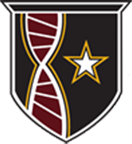Technology Transfer
Merit
Potential
Strategies
Technology Transfer (T2) is a collaborative process from which all participants can benefit. The evolution of T2 since 1980 has made it increasingly easier for USAMRIID laboratory scientists to bring funding, personnel, information, and resources into the USAMRIID community from outside sources through participation in the process. Outside sources may also realize these same benefits from the Command although government funding is strictly limited to specific arrangements when they participate in the process.
Mechanisms: USAMRIID is an important partner with academia, industry, and other eligible entities in this process and utilizes a number of mechanisms for establishing the essential collaborative relationship.
Critical Components in Technology Transfer
- Cooperative Research and Development Agreements (CRADAs)
- Material Transfer Agreements (MTAs)
- Patent licenses
- Technical meetings
- Information dissemination/collegial interchange
- Cooperative agreements
Cooperative Research and Development efforts, especially CRADAs, have the greatest potential for long-term payoff of any T2 mechanism. They allow USAMRIID scientists to better understand the technology needs of the commercial sector and facilitate a reverse flow of ideas, resources, and funds into the laboratories and are the linchpins of the Command’s technology transfer program.
What is a CRADA?
A CRADA is an agreement between one or more federal laboratories and one or more nonfederal parties under which the laboratories provide personnel, facilities, or other resources and the nonfederal parties provide funds, personnel, services, facilities, equipment, or other resources to conduct specific research or development efforts that are consistent with the laboratory’s mission.
Steps:
- USAMRIID scientist finds a prospective partner and works out a draft statement of work (SOW)
- Scientistrequests a CRADA from USAMRIID's Office of Research and Technology Applications (ORTA) via a Request for CRADA Preparation Form, including approval signature from department and division heads
- ORTA prepares draft CRADA and obtains legal review from U.S. Army Medical Research and Development Command (USAMRDC)
- ORTA sends draft CRADA to prospective partner and negotiates terms and conditions
- ORTA obtains approval from laboratory commander/director and initiates USAMRIID and the Department of the Army review (normally routine)
- CRADA signed by laboratory commander/director
Attributes:
- The heart of a CRADA is the SOW
- The government cannot provide funds to a nonfederal entity—other mechanisms exist for that purpose
- Intellectual property (IP) rights in existence prior to a collaboration are retained by the provider, while any rights to newly created IP are negotiated on a case-by-case basis subject to applicable law and regulation
What is an MTA?
An MTA is a short-form CRADA solely for the provision of materials and information between a laboratory and a nonfederal party. No collaboration is contemplated.
What is a Patent License?
A patent license is a contractual agreement between a licensor (IP owner) and a licensee granting the licensee the right to use or develop the IP in exchange for a royalty fee.
Attributes:
- U.S. industry/small businesses preferred
- Can be exclusive, nonexclusive (preferred), for specific field of use, or a specific geographic area
- Substantial royalties return to the laboratory
- Licensee must present plans to commercialize the invention
- Government obtains a nonexclusive, royalty-free, worldwide license
- Subject to conflict-of-interest rules
Royalty Income Use
The inventor receives the first $2,000 and 20% thereafter up to $150,000/year of any royalties/payments resulting from commercial licensure.
The USAMRIID laboratory receives the residual income to:
- Reward laboratory employees, including inventors of technology regardless of whether it has commercial application
- Further scientific exchange among laboratories
- Educate and train USAMRIID employees
- Pay the expenses incidental to the administration and licensing of inventions
- Support T2 marketing activities
What is a Dual-Use Science and Technology (DUST) Program?
It is a Department of Defense (DoD) program that is a pillar of T2, as it promotes technologies that have both military utility and sufficient commercial potential to support a viable industrial base. One of the main focus areas of the DoD program is directed at medical and bioengineering technologies.
Requirements:
- Dual-use technology
- Competitive
- Non-procurement agreement (cooperative agreement or other transaction)
- Cost share (50% partner/25% DoD/25% Army)
Legislative History
1980
- Stevenson-Wydler Technology Improvement Act
- Established T2 as government mission
- Established Offices of Research and Technology Applications
- Bayh-Dole Patent and Trademark Amendments Act
- Permitted universities, not-for-profit organizations, and small businesses to obtain title to inventions developed with government support
1986
- Federal Technology Transfer Act
- Authorized CRADAs
- Authorized laboratory invention and intellectual property rights to be granted and waived
- Required patent license royalties to be shared with government employee inventors
1989
- National Competitiveness Technology Transfer Act
- Essentially extended the same T2 and CRADA authorities to Government-Owned Contractor-Operated laboratories
1995
- Technology Transfer Improvement Act of 1995
- Guaranteed private companies the option of choosing an exclusive license for an invention created under a CRADA
For more information please contact:
U.S. Army Medical Research Institute of Infectious Diseases
Office of Research Technology Applications
Phone (commercial): 301-619-8256
Phone (DSN): 343-8256
Email: usarmy.detrick.medcom-usamriid.mbx.rpo@health.mil
Mailing address:
USAMRIID
Attn:FCMR-UIZ-M
1425 Porter Street
Fort Detrick, MD 21702-5011













